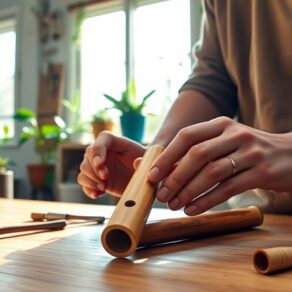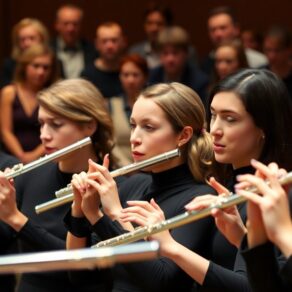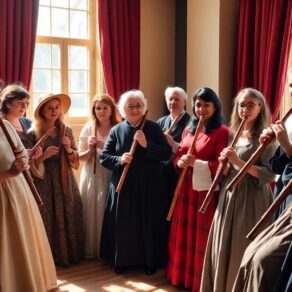As a flutist, knowing iconic orchestral solos is essential. Mozart's Flute Concerto No. 1 offers lyrical melodies combined with intricate technical challenges. Debussy's "Prélude À L'après-Midi D'un Faune" presents rich textures that resonate with sensuality. Nielsen's Flute Concerto pushes boundaries with its innovative techniques and emotional depth. Don't overlook Bach's Brandenburg Concerto No. 5, which showcases the flute's dialogue within an ensemble. Tchaikovsky's "Nutcracker Suite" and Ibert's Concerto also merit your attention. Each piece reveals unique expressive and technical elements, shaping your artistry. Discovering more about these works can enhance your performance and musical connection markedly.
Key Takeaways
- Mozart's Flute Concerto No. 1 features lyrical melodies and technical agility, essential for any flutist's repertoire.
- Bach's Brandenburg Concerto No. 5 showcases intricate flute passages and rich dialogue with other instruments, highlighting Baroque ornamentation.
- Debussy's "Prélude À L'après-Midi D'un Faune" embodies impressionistic textures, allowing flutists to explore sensual and lyrical expressions.
- Ibert's Concerto offers vibrant motifs and emotional depth, pushing flutists to master technical challenges and expressive nuances.
- Tchaikovsky's "Nutcracker Suite" includes enchanting flute solos, creating magical moments that engage audiences and enhance musicianship.
Mozart's Flute Concerto No. 1
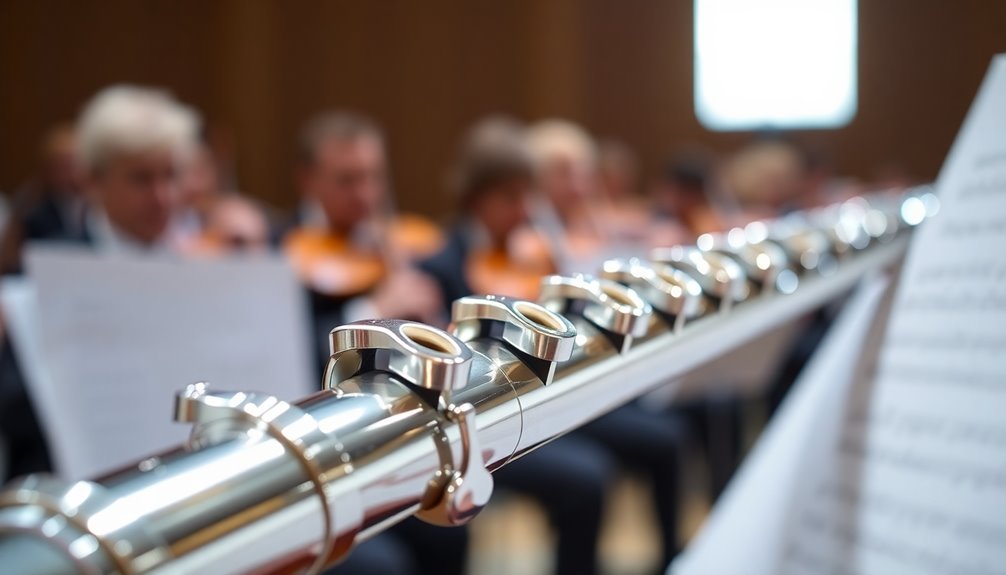
In the late 18th century, Mozart's Flute Concerto No. 1 in G major emerged as a cornerstone of the flute repertoire, showcasing the instrument's expressive capabilities. You'll notice that Mozart's style is characterized by lyrical melodies and intricate harmonies, creating an engaging dialogue between the solo flute and the orchestra.
This concerto serves not only as a technical challenge but also as an emotional exploration for flutists. As you explore the piece, pay attention to the various flute techniques employed throughout. The rapid passages demand agility and precision, while the lyrical sections invite a more expressive interpretation.
You'll find that the interplay of staccato and legato passages highlights the flute's versatility, allowing you to showcase your artistry. Moreover, the charming cadenzas provide an opportunity for personal expression, encouraging you to infuse your unique voice into the performance. Additionally, practicing with familiar melodies can enhance your skill development and overall musicality.
Studying this concerto not only hones your technical skills but also deepens your understanding of classical music's emotional depth. By immersing yourself in Mozart's Flute Concerto No. 1, you'll connect with a timeless work that continues to resonate with flutists and audiences alike.
Debussy's "Prélude À L'après-Midi D'un Faune"

While Mozart's Flute Concerto No. 1 set a high standard for flute repertoire, Debussy's "Prélude À L'après-Midi D'un Faune" takes the instrument into a domain of rich impressionistic textures and evocative imagery. In this work, the flute embodies the Faun's symbolism, capturing both sensuality and longing through its melodic lines. As you explore the nuances of Debussy's Impressionism, you'll find that the flute's role is pivotal in conjuring a world of dreams and nature. The emotional depth of traditional flute melodies enhances the storytelling elements woven into this iconic piece.
The following table highlights key aspects of this iconic piece:
| Element | Description | Significance |
|---|---|---|
| Flute Melody | Lyrical, sinuous phrases | Represents the Faun's desire |
| Orchestral Texture | Rich harmonies and colors | Creates an ethereal atmosphere |
| Rhythmic Freedom | Fluid, free-flowing rhythms | Mirrors the Faun's carefree spirit |
| Thematic Development | Repetition and transformation | Evokes the journey of longing |
Nielsen's Flute Concerto
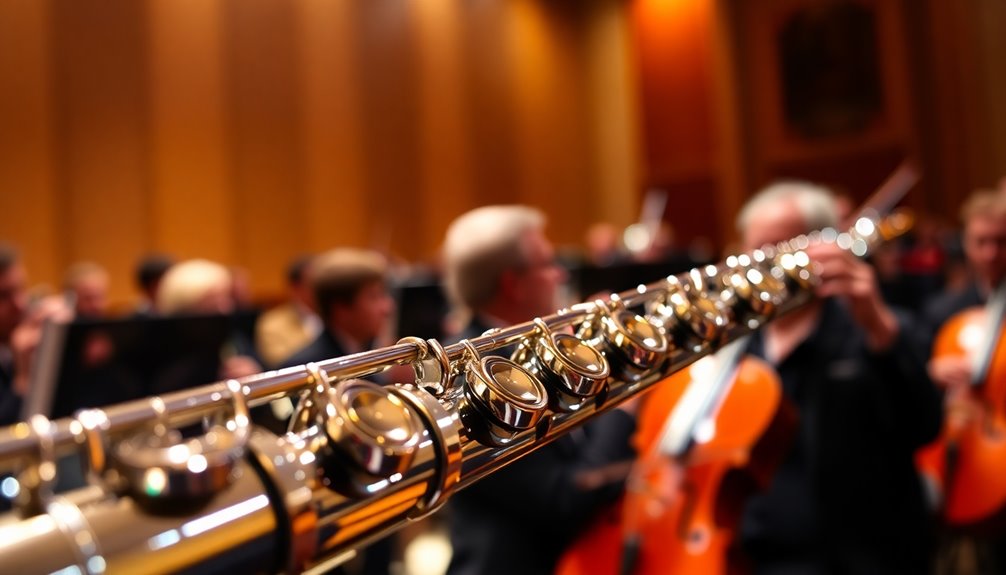
Nielsen's Flute Concerto stands out as a remarkable fusion of technical prowess and expressive depth, inviting you to investigate the complexities of the flute within a vibrant orchestral landscape. Written in 1926, this piece reflects Nielsen's influences, particularly his interest in folk melodies and the natural world, which permeate the work and give it a distinctive character.
As you explore the concerto, you'll encounter a blend of innovative flute techniques that challenge the player while enhancing the overall texture of the music. The soloist navigates rapid passages, soaring melodies, and intricate rhythmic patterns, all crafted to showcase the flute's versatility.
Within the orchestral context, the interplay between the flute and the ensemble creates a dynamic dialogue, highlighting both the soloist's individuality and the collective sound.
Nielsen's modern composition style fosters a sense of exploration, urging you to embrace the contrasts between lyricism and complexity. This concerto not only serves as a technical benchmark but also as an emotional journey, making it essential for any flutist seeking to understand the instrument's role in contemporary orchestral music. Mastery of articulation techniques is crucial to fully express the nuances present in Nielsen's writing.
Bach's Brandenburg Concerto No. 5
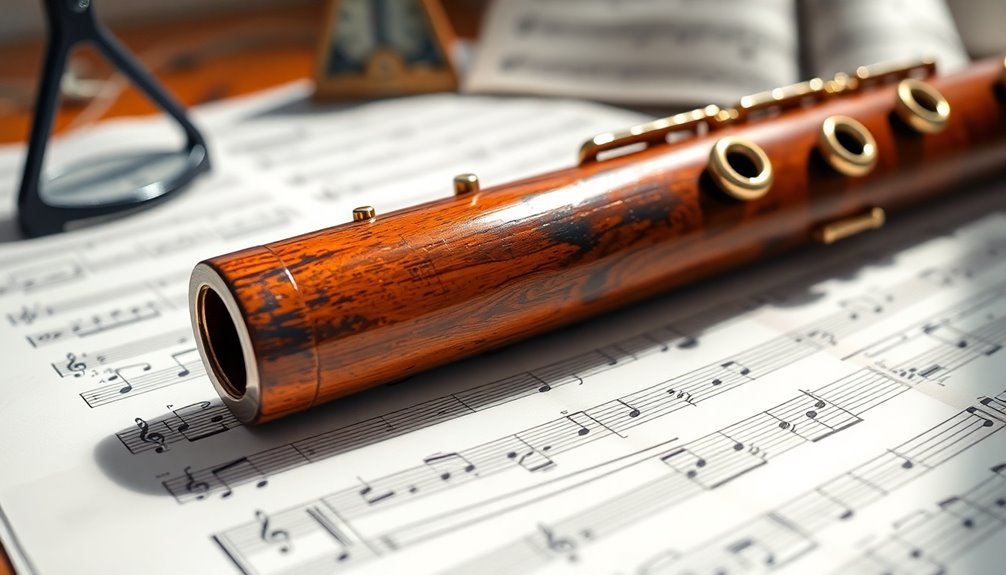
The exploration of iconic flute solos continues with Bach's Brandenburg Concerto No. 5, a cornerstone of the Baroque repertoire that showcases the instrument's lyrical capabilities within a rich tapestry of orchestral sound.
Bach's orchestration is masterful here, as he intertwines the flute with the violin and harpsichord, creating a dialogue that highlights each instrument's unique voice.
This concerto isn't just a display of technical prowess; it's deeply rooted in its historical context. Composed around 1721, it reflects the flourishing of Baroque influences, where ornamentation and expressive phrasing were paramount.
As a flutist, you'll appreciate the intricate flute techniques employed, from rapid passages to long, soaring lines that demand both agility and emotional depth.
Engaging with this work allows you to connect not only with Bach's vision but also with the broader musical traditions of the era.
The interplay between the flute and the ensemble offers a rich canvas for interpretation, inviting you to explore both the technical and expressive possibilities of your instrument. Additionally, understanding the material quality and durability of your flute can enhance your performance experience, ensuring that your instrument remains reliable throughout your practice.
Embrace the challenge, and you'll find a rewarding journey through one of Bach's most celebrated masterpieces.
Tchaikovsky's "Nutcracker Suite"
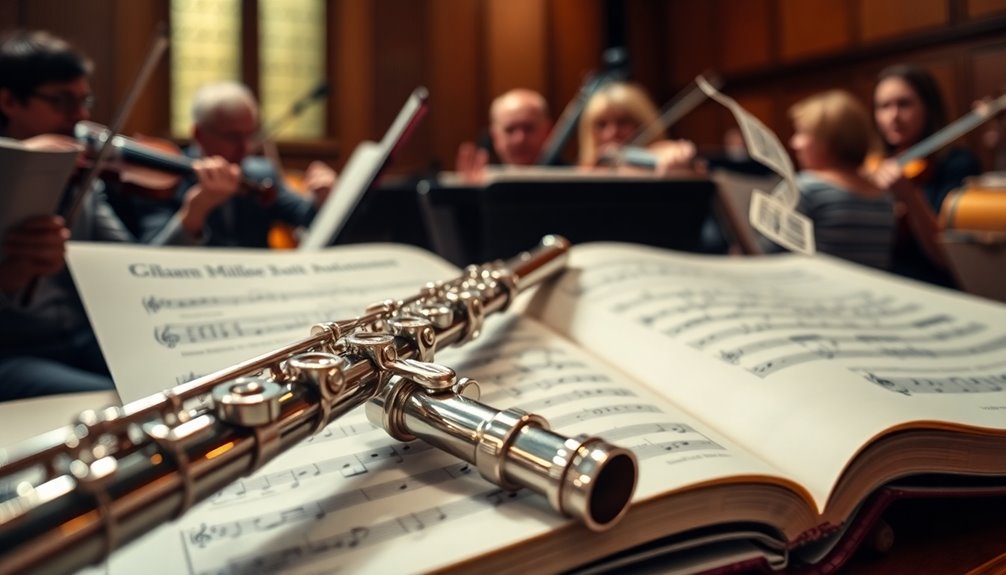
Magic permeates Tchaikovsky's "Nutcracker Suite," particularly through the enchanting flute solos that evoke a sense of wonder and celebration. These moments showcase the flute's ability to weave delicate melodies that transport listeners into a dreamlike domain, embodying Tchaikovsky's inspiration drawn from E.T.A. Hoffmann's tale. Each solo invites you to explore the intricacies of the music, highlighting the flute's expressive capabilities.
In "Dance of the Sugar Plum Fairy," the flute dances gracefully alongside the celesta, creating a magical dialogue that feels both ethereal and grounded. This interplay not only emphasizes the beauty of the flute but also cements the Nutcracker's legacy as a cornerstone of the holiday season. You can hear the joy and festivity in every note, making it a must-learn piece for any flutist seeking to connect with audiences. Additionally, engaging with such repertoire fosters musicianship and skill enhancement, ensuring that flutists continually develop their technical abilities and artistic expression.
As you explore these solos, you'll find a profound link to the rich tradition of orchestral music. Tchaikovsky's work invites you to embrace your artistry while celebrating the timeless charm of the Nutcracker, ensuring that you, too, can be a part of its enchanting legacy.
Strauss's "Ein Heldenleben"
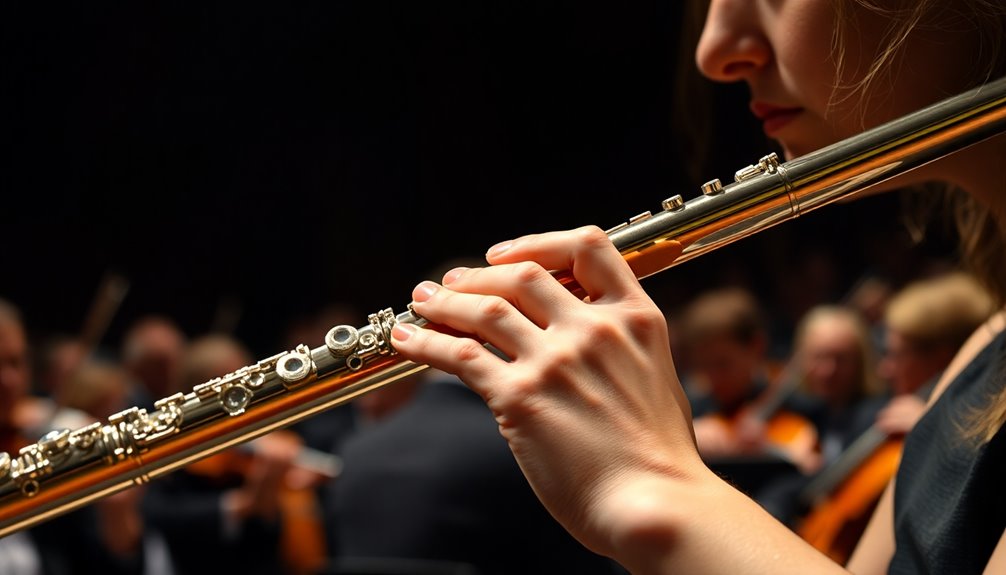
Flute solos in orchestral compositions often exemplify the instrument's lyrical prowess, and Richard Strauss's "Ein Heldenleben" is no exception. This piece showcases the flute's ability to convey a range of emotions, seamlessly aligning with Strauss's themes of heroism and introspection. The flute's passages often reflect the protagonist's journey, allowing you to feel the underlying narrative through its soaring melodies.
As you explore this work, consider these key aspects:
- Expressive Dynamics: Notice how the flute's dynamic range enhances the emotional depth of the solos.
- Technical Flourishes: Pay attention to the intricate runs and trills that highlight advanced flute techniques, showcasing virtuosity.
- Orchestral Interaction: Observe how the flute interacts with the orchestra, weaving in and out of the texture, creating a dialogue that emphasizes its role.
Mastering these elements not only enriches your interpretation but also deepens your connection to Strauss's intentions. The concert flute, with its bright and versatile sound, serves as a perfect medium for the emotional storytelling found in this piece.
"Ein Heldenleben" serves as a quintessential example of how the flute can embody a hero's journey, encouraging you to embrace both the technical and emotional aspects of your performance.
Prokofiev's "Peter and the Wolf"

Prokofiev's "Peter and the Wolf" offers a fascinating exploration of character through orchestral color, with the flute playing a crucial role in the narrative. As you investigate this work, you'll notice how Prokofiev's themes emerge vividly through distinct musical motifs. The flute, representing the bird, shines with a light, playful quality, capturing the essence of its character portrayal. Its agile runs and fluttering phrases create a sense of freedom and whimsy that contrasts beautifully with the more ominous themes expressed by other instruments.
When you perform the flute part, you're not just playing notes; you're embodying the spirit of the bird, weaving through the story's emotional landscape. The careful interplay between the flute and the orchestra highlights the narrative's progression, allowing you to connect deeply with the audience. Moreover, incorporating moisture control solutions into your practice routine can enhance your performance quality by ensuring consistent playability of the instrument.
Prokofiev's skillful orchestration enables you to explore the interplay of light and dark, innocence and danger, accentuating the character dynamics at play.
In "Peter and the Wolf," the flute isn't just an instrument; it becomes a voice, inviting listeners into a world where music tells a story, making it a crucial piece every flutist should know.
Ibert's Concerto for Flute
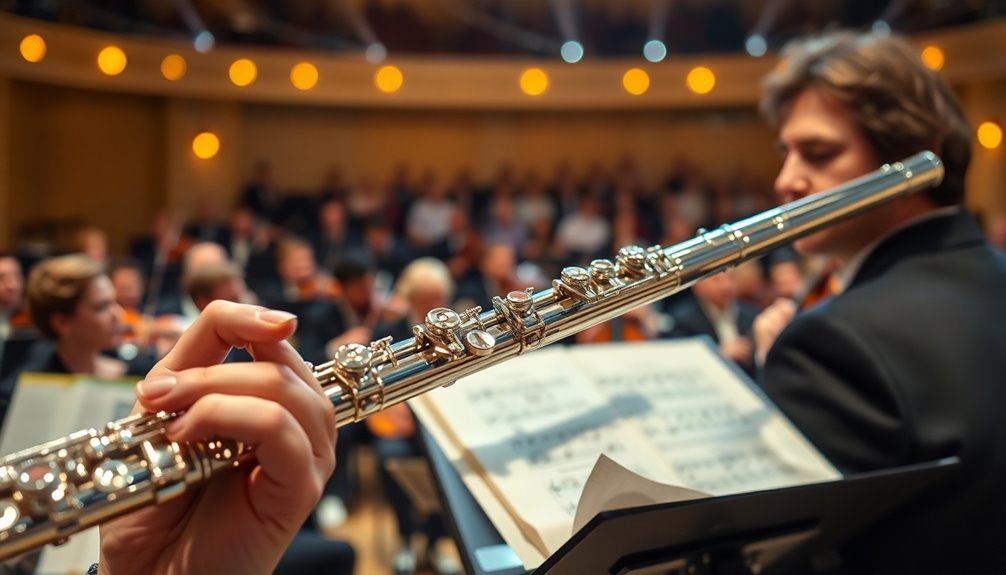
How does Ibert's Concerto for Flute elevate the instrument into a domain of both technical brilliance and expressive depth? This piece showcases Ibert's style, which blends playful motifs with intricate orchestral integration, allowing the flute to shine as both a soloist and an integral part of the ensemble.
The concerto's three movements reveal a rich tapestry of emotions, where you can explore diverse flute techniques, from rapid passages to lyrical phrases.
When analyzing this work, consider the following:
- Contrast: Notice how Ibert juxtaposes lively, rhythmic sections with more contemplative moments, creating a dynamic listening experience.
- Technical challenges: Embrace the intricate passages that test your skills and push the boundaries of flute performance.
- Expressive range: Pay attention to the emotional depth conveyed through the flute, allowing you to connect more profoundly with the music.
Ibert's Concerto for Flute not only highlights the instrument's capabilities but also invites you to immerse yourself in a world where technical prowess meets heartfelt expression. This piece is essential for any flutist aiming to understand the nuances of modern orchestral repertoire and enhances skills through diverse techniques that allow for greater musical interpretation.
This piece is essential for any flutist aiming to understand the nuances of modern orchestral repertoire.
Copland's "Appalachian Spring"
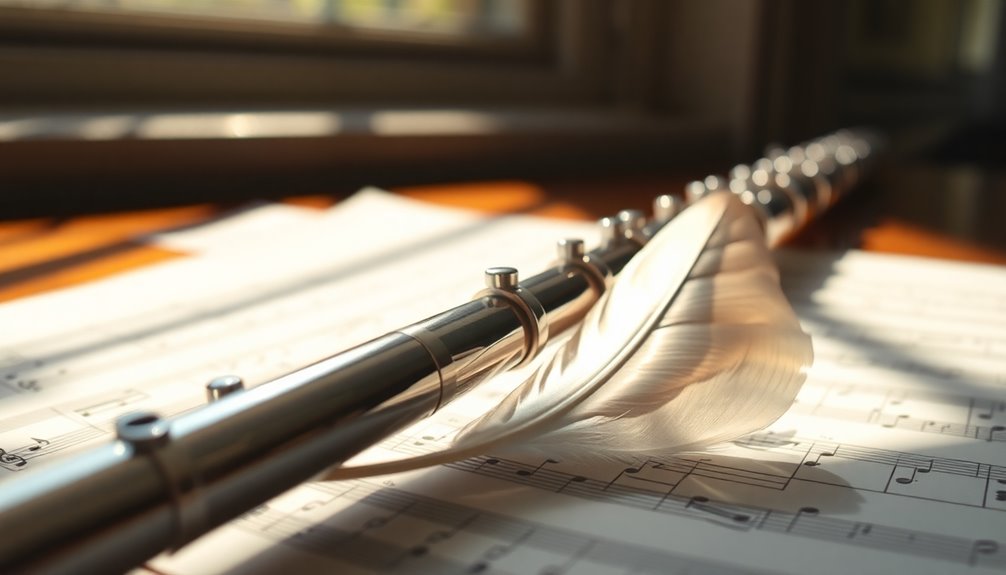
One of the most celebrated works in the American orchestral canon, Copland's "Appalachian Spring" beautifully showcases the flute's lyrical capabilities within a rich tapestry of orchestral textures.
As you investigate this piece, you'll notice how Copland weaves Appalachian themes into its fabric, creating a sense of pastoral serenity that resonates deeply with listeners.
The flute plays a pivotal role, employing various flute techniques that highlight its expressive potential. From the gentle, flowing melodies to the more spirited passages, the flute captures the essence of springtime and the beauty of rural life.
As you explore the solo lines, pay attention to the nuances in dynamics and articulation—these elements breathe life into the music, allowing you to connect with the emotions portrayed.
Moreover, the interplay between the flute and the orchestra demonstrates a conversation that speaks to the heart of ensemble playing.
You'll find that mastering these passages not only enhances your technical skills but also enriches your musical expression, making "Appalachian Spring" an essential piece for every flutist's repertoire. Additionally, understanding the importance of breath control can significantly improve your performance of this piece.
Embrace its lyrical charm and let it inspire your own musical journey.
Frequently Asked Questions
What Are the Best Practice Techniques for Developing Flute Solos?
To develop your flute solos effectively, focus on tone production and breath control. Start with long tones to build a solid foundation, ensuring your sound is rich and resonant.
Incorporate scale exercises to enhance your technique and agility. Regularly practice dynamics and phrasing to express emotional depth in your playing.
Finally, record yourself to identify areas for improvement, creating a sense of community by sharing your journey with fellow flutists.
How Can I Improve My Orchestral Playing Skills?
To improve your orchestral playing skills, focus on tone production, refine your technique, and listen intently.
You'll enhance your ensemble dynamics by blending with other instruments, adjusting your volume, and matching articulations.
Practicing with a metronome can sharpen your rhythmic accuracy, while recording yourself allows you to self-evaluate.
Engaging in group rehearsals fosters teamwork and builds camaraderie.
Embrace these strategies, and you'll find yourself growing as a confident, cohesive musician.
What Equipment Is Essential for Playing Flute in an Orchestra?
To excel in orchestral settings, you need reliable equipment that enhances your performance.
Start with a well-maintained flute; regular flute maintenance guarantees peak sound quality. A solid case protects your instrument during transport, while a good cleaning kit keeps it in top shape.
Additionally, consider a tuner and metronome to help you navigate orchestral dynamics. These tools not only support your playing but also foster a sense of belonging within the ensemble.
Are There Any Online Resources for Learning These Iconic Solos?
Imagine a treasure chest brimming with jewels, each representing an iconic flute solo waiting for you. To access these gems, explore online tutorials that guide you through techniques and interpretations.
Websites like YouTube and specialized music platforms offer step-by-step videos to help you master each piece. Don't forget to seek out sheet music from reputable sources, ensuring you've got the right tools to shine in your musical journey.
Embrace this community; you're not alone!
How Do I Choose the Right Flute for Orchestral Performances?
Choosing the right flute for orchestral performances involves considering several factors.
Start by exploring reputable flute brands known for their quality, like Yamaha or Pearl. Pay attention to the material and tone, as they greatly impact your sound.
Don't forget about instrument maintenance; a well-maintained flute can enhance your performance.
Ultimately, test various flutes to find one that feels comfortable and resonates with you, ensuring you can express yourself confidently in the ensemble.
Conclusion
So, there you have it—an arsenal of flute solos that'll have you strutting your stuff in any orchestra. Sure, you could spend hours perfecting your scales, but why not dazzle your audience with these iconic pieces instead? After all, who needs a perfectly executed G major scale when you can channel your inner Mozart or Debussy? Embrace these masterpieces, and let your flute do the talking—because when it comes to orchestral flair, subtlety is overrated!


